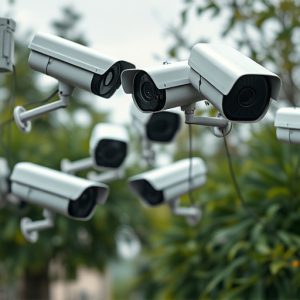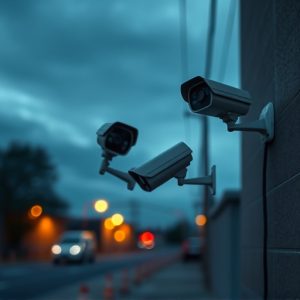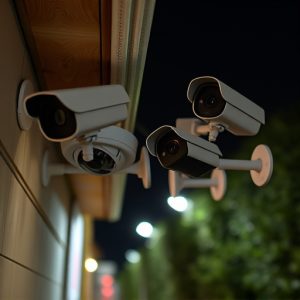Do Fake Security Cameras Deter Crime? Analyzing Their Role and Real-World Impact
Fake security cameras can be a double-edged tool in crime prevention. While their presence may deter…….
Fake security cameras can be a double-edged tool in crime prevention. While their presence may deter less sophisticated criminals by suggesting a comprehensive surveillance network and evoking a fear of being caught, their effectiveness diminishes against individuals familiar with dummy cameras who might perceive them as an opportunity rather than a threat. The actual impact of these decoys is context-specific; they work best when part of a multi-layered security strategy that includes real surveillance systems, and when placed in environments where the potential criminal lacks sophistication or knowledge about their deceptive nature. In retail settings, reports indicate a reduction in shoplifting incidents after the installation of dummy cameras, indicating their value as a low-cost deterrent in such contexts. However, in areas with higher crime rates and more experienced criminals, their protective benefits may be negated. Therefore, to answer the question "Do fake security cameras work?"—they can serve as an effective component within a broader security framework, but their standalone utility is limited and must be carefully assessed based on the specific security needs of a property and the level of threat sophistication.
title: Do Fake Security Cameras Deter Crime? Exploring Their Role in Safety
In an era where sophisticated surveillance systems are commonplace, the debate persists on whether fake security cameras can effectively contribute to a site’s safety. This article delves into the intricacies of dummy cameras, examining their functionality and effectiveness, psychological impact as both a deterrent and a deceptive tool, and providing real-world examples that shed light on their efficacy in various settings. Join us as we explore the question: do fake security cameras work?
Understanding Fake Security Cameras: A Primer on Their Functionality and Effectiveness
The landscape of home and business security has evolved significantly with the advent of advanced surveillance technology. Amidst this technological growth, the efficacy of fake security cameras as a deterrent against theft or vandalism remains a subject of debate. Fake security cameras, also known as decoy cameras or dummy CCTV units, are designed to mimic the appearance of real surveillance equipment. They often lack the necessary components to record or transmit footage but are crafted to deceive potential intruders.
While their primary function is to create the illusion of constant monitoring, the effectiveness of these devices hinges on a few key factors. Firstly, their placement and design must be convincing enough to persuade an intruder that they are part of a comprehensive surveillance system. If executed correctly, fake cameras can serve as an effective deterrent by suggesting that any misdeed is likely to be captured and could lead to identification and apprehension. However, their utility is largely contingent on the criminal’s belief in their presence. In areas with actual security measures, the presence of a few dummy cameras can supplement real surveillance coverage without significantly impacting the overall security posture. Conversely, in locations where there are no security systems, fake cameras alone may not provide substantial protection and could give a false sense of security. It’s crucial to consider the context in which these devices are deployed; their effectiveness is often situational and depends on various factors, including the sophistication of potential threats and the overall security strategy in place.
The Psychological Impact of Dummy Security Cameras: Deterrence vs. Deception
The deployment of dummy security cameras has been a subject of debate among security experts and psychologists, particularly concerning their effectiveness in deterring criminal activity. On one hand, the presence of visible surveillance equipment, whether real or fake, can have a significant psychological impact on potential intruders. This is because the mere suggestion of being observed can trigger an automatic fear response, causing individuals to reconsider their actions due to the perceived risk of getting caught. Dummy cameras serve as a form of deterrence by simulating the all-seeing eye of a real surveillance system, which can effectively discourage malicious activities in public and private spaces.
However, the effectiveness of fake security cameras is not without nuances. While they may act as a deterrent for some individuals who are sensitive to the threat of being watched, others might perceive these cameras as a deceptive measure. Over time, criminals with more sophisticated knowledge may discern the difference between real and fake cameras, potentially leading to a false sense of security or even emboldening them to target locations they believe are less secure. It’s crucial for property owners to understand that while dummy cameras can play a role in crime prevention through involuntary behavior modification, they should be part of a comprehensive security strategy that includes a combination of visible security measures and responsive protocols to ensure genuine protection.
Case Studies and Real-World Examples: Assessing the Efficacy of Fake Security Systems in Different Contexts
Studies and real-world applications have shown that the effectiveness of fake security cameras in deterring criminal activity varies across different contexts. For instance, in a retail setting where visual surveillance is a known deterrent, the presence of even simulated cameras can significantly reduce shoplifting incidents. Businesses reported a noticeable decrease in theft after installing dummy cameras, suggesting that the perceived threat of being caught is often as effective as actual surveillance. However, the efficacy of these decoys is contingent on various factors, including the sophistication of the fake cameras and the criminal’s awareness of their presence. In residential areas, while real security systems are preferred for actual protection, some homeowners have adopted fake cameras as a cost-effective alternative to enhance the appearance of a secure property. The psychological impact of these visual cues persuades potential intruders to target less fortified homes. Conversely, in high-crime neighborhoods where criminals are more likely to be familiar with surveillance systems, the utility of fake cameras is diminished. Their effectiveness is further compromised if the criminal element becomes aware of their deceptive nature, rendering them little more than an optical illusion rather than a genuine security measure. In such contexts, integrating dummy cameras as part of a layered security approach, alongside real cameras and other deterrents, can still offer some level of protection against less sophisticated criminals. The key takeaway is that while fake security cameras may not replace real surveillance systems, they can be a useful component in a broader strategy to enhance safety and security in various environments.


